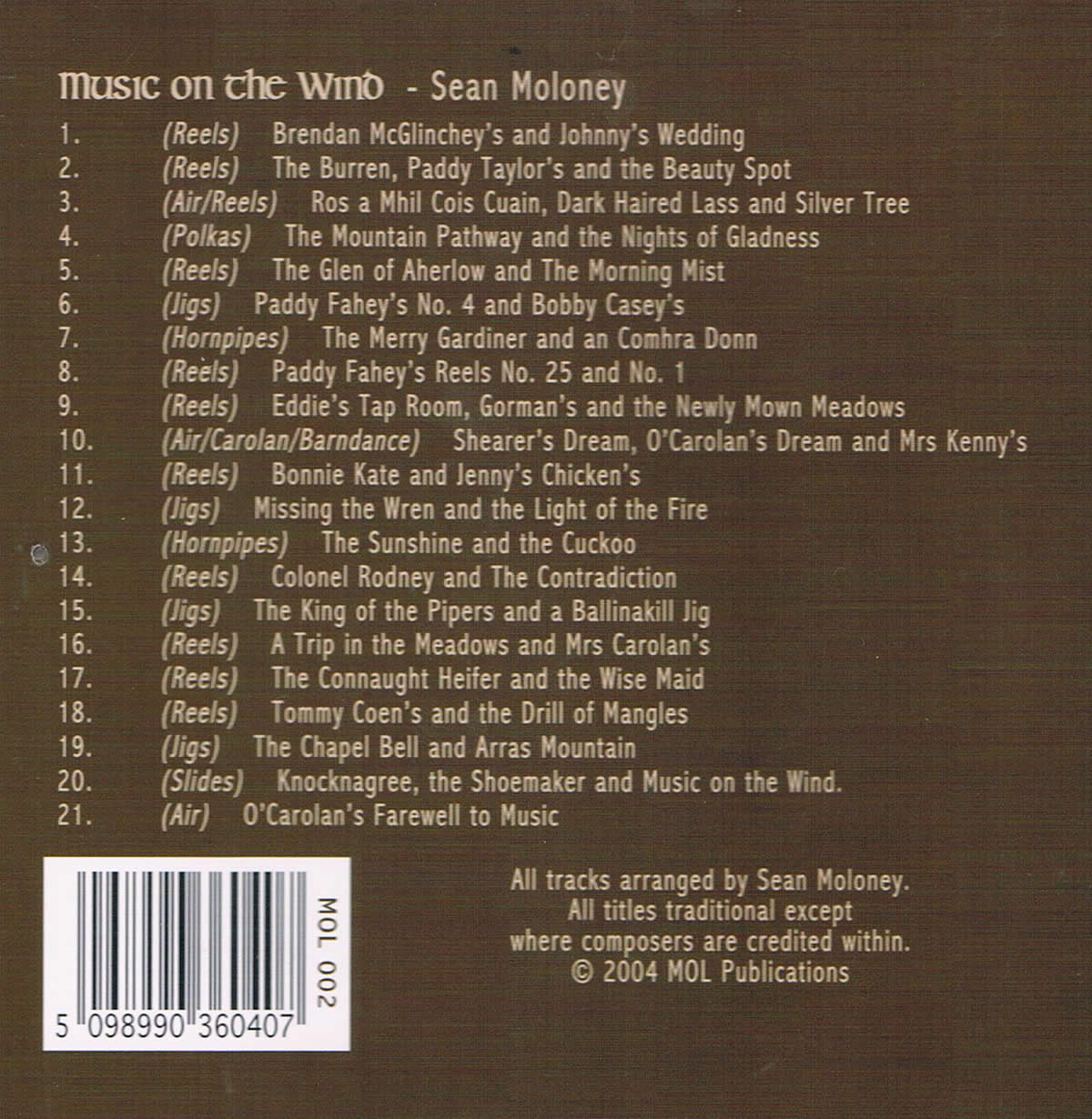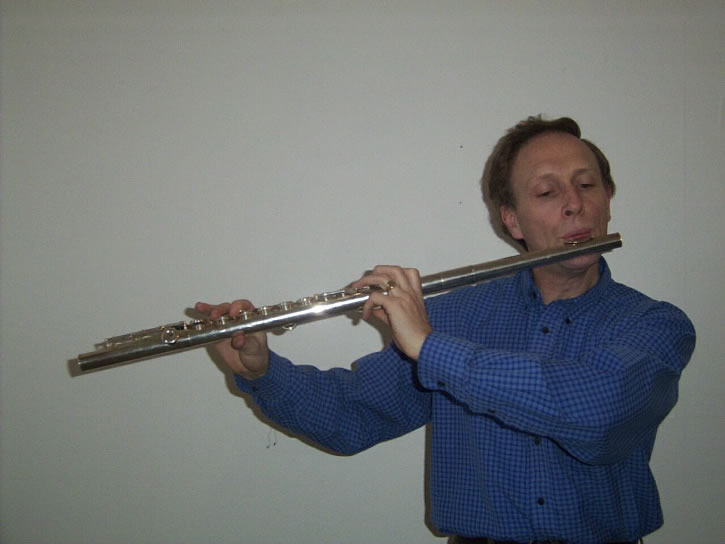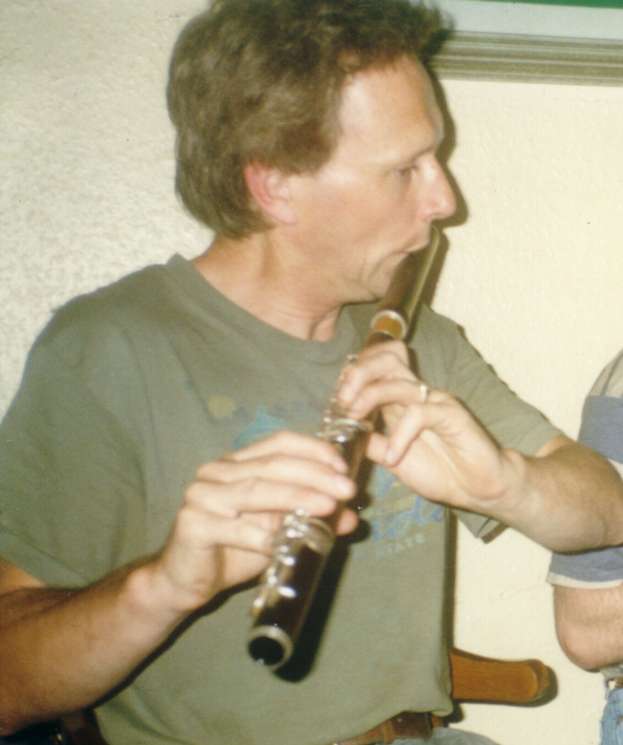Seán Moloney
Traditional Irish Flautist




|
1. (Reels) McGlinchey’s and Johnny’s Wedding The first one is a composition of fiddle player Brendan McGlinchey. The second I learned from the great late east-Galway flute player Paddy Carty. |
|
2. (Reels) The Burren, Paddy Taylor’s and the Beauty Spot The Burren is a geologically and visually unusual landscape in north County Clare. Concertina player from this area, Chris Droney plays this tune. Paddy Taylor’s is called after the late Limerick flute player. My friend and fiddle player Liam Lewis was the first person I heard playing the first two tunes. As a youngster I used to hear my uncle Kieran Quinn, from Woodford, playing the Beauty Spot. |
|
3. (Air and Reels) Ros an Mhil Cois Cuain, The Dark Haired Lass and The Silver Tree The first is the air of a sean-nos song popular in recent years in Conamara. I first heard Nain Grealish singing this in the early 80’s while we were recording the TV programme “Bring Down the Lamp” for RTE. The two reels, which follow, were favourites of my father, Eddie, who in turn learned them from my grandfather, Stephen Moloney. |
|
4. (Polkas) The Mountain Pathway and the Nights of Gladness I learned these tune years ago from my father Eddie and accordion player Vincent Keegan, who together with guitarist Mike Fahey and sometimes myself played collectively as a group called the Sea Captains. Breda Lewis, mandolin player, informed me that these tunes were called the Nights of Gladness in County Wexford. |
|
5. (Reels) The Glen of Aherlow and The Morning Mist The first tune is a composition of the late fiddle player, Sean Ryan, from Nenagh. The famous Loughrea accordion player Joe Burke composed the second one. |
|
6. (Jigs) Paddy Fahey’s No. 4 and Bobby Casey’s East Galway and west Clare fiddlers respectively composed these two jigs. |
|
7. (Hornpipes) The Merry Gardiner and an Comhra Donn The first is a favourite of Muintir Lewis, the only musicians I have ever heard playing this lovely tune. The second is a setting of the tune an Comhra Donn, which can be found in Breandan Breathnach’s Ceol Rince na hEireann |
|
8. (Reels) Paddy Fahey’s Reels No. 25 and No. 1. Two more wonderful compositions of Paddy Fahey’s, which I am playing on alto flute and dubbing on the fiddle. |
|
9. (Reels) Eddie Moloney’s Own, Gorman’s and the New Mown Meadows I learned these three from my late father, Eddie. The first is a composition of Eddie’s. The name for the second came from accordion player Charlie Piggot and the third from piper Emmett Gill |
|
10. (Air, March and Barndance) The Shearer’s Dream, O’Carolan’s Dream and Mrs Kenny’s The first is the air of an Australian folksong, which I got from the much-loved Australian folksinger and painter Brian Mooney who lived in Galway for many years. O’Carolan’s Dream, I got from sheet music – I never heard anyone playing this tune. I got the final tune from a ‘78’ by the famous Sligo fiddle player, Michael Coleman. |
|
11. (Reels) Bonnie Kate and Jenny’s Chicken’s Two more tunes, the settings of which are close to Michael Coleman’s. I heard these tunes played first by one of my favourite fiddle players Andy MCGann. |
|
12. (Jigs) Missing the Wren and the Light of the Fire Traditionally musicians, singers, dancers and story-tellers dress up in disguise (often with straw attire) and go out “on the wren” (celebrating the bird) or “mumming”, which involves going from place to place performing to the village. I made up the tune ‘Missing the Wren’ in the millennium year on St Stephen’s day, wren day, when I thought I wouldn’t make it out due to a cold, but as the day progressed I improved and eventually did make the “Wren” with my wife Irene and fiddle player Sheila O’Dowd. The second tune came to me in 1998, again on the fiddle, while I was playing in front an open turf fire. |
|
13. (Hornpipes) The Pansy Blossom and the Cuckoo Both of these I learned from playing with accordion player Vincent Keegan and my father. A version of the first tune appears in O’Neill’s collection. |
|
14. (Reels) Colonel Rodney and The Contradiction Two more from my father, Eddie. The second one was very much favoured by the master fiddle players of east Galway, like Paddy Kelly, Tommy Coen, Kevin Moloney (all RIP) and Paddy Fahey. |
|
15. (Jigs) The King of the Pipers and a Ballinakill Jig The first tune was a favourite of the old Donegal fiddle players. I first heard it from Charlie Piggot. The second I learned from my father. Ballinakill flute players, Mike and Mary Raftery, have also recorded this tune. |
|
16. (Reels) A Trip in the Meadows and Mrs Carolan’s Lucy Farr gave me the first tune. Sligo flute player, Liam O’Hara, who resides in Carna, Co. Galway, provided the name. The second tune I learned from concertina player JimMcArdle from Bettystown, Co. Meath. Jim collected the tune from County Louth concertina player of the past, Margaret Carolan. |
|
17. (Reels) The Connaught Heifer and the Wise Maid I learned this tune from Dublin fiddle player Edel McWeeney. The Wise Maid is one of the most played reels around, but is still one of my favourites. |
|
18. (Reels) Tommy Coen’s and the Drill of Mangles Tommy Coen was a very fine fiddle player from east Galway, who played in the unique style of that area. He lived his working life in Lower Salthill, where I was brought up. I remember him playing with my father many times in the 1960’s. These are two of Tommy’s compositions, which were recorded by Father Dan Lyons. |
|
19. (Jigs) The Chapel Bell and Arras Mountain Both of these tunes I learned from Mick Clancy, a multi-instrumentalist from Manorhamilton, County Leitrim. The name of the first tune is from Emmett Gill. Accordion player Johnny O’Halloran from Inishboffin Island calls it Why Johnny Why. The second tune came from accordion player, Paddy O’Brien from Nenagh. |
|
20. (Slides) O’Sullivan’s, the Shoemaker and Music on the Wind. The first is a tune from the Sliabh Luachra area of east Kerry/west Cork. The last two tunes were composed by Lucy Farr (nee Kirwin). They are wonderful lively tunes, which are full of the richness and essence of our traditional music. |
|
21. (Air) O’Carolan’s Farewell to Music This transcendental tune was composed by the blind, seventeenth-century, harpist Turlough O’Carolan. I first heard it played by harpist, Maire Ni Chathasaigh. |